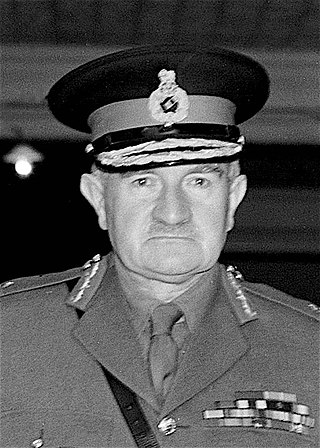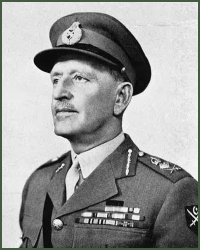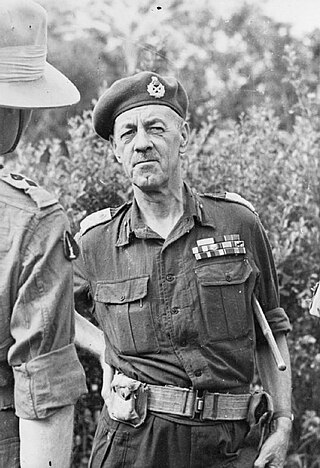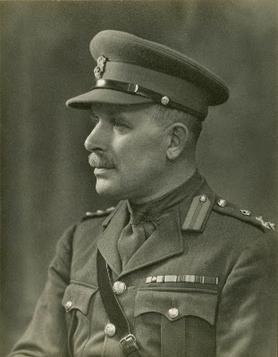Related Research Articles

The Chindits, officially known as Long Range Penetration Groups, were special operations units of the British and Indian armies which saw action in 1943–1944 during the Burma Campaign of World War II.

Field Marshal William Joseph Slim, 1st Viscount Slim,, usually known as Bill Slim, was a British military commander and the 13th Governor-General of Australia.
General Sir Alexander Frank Philip Christison, 4th Baronet, was a British Army officer who served with distinction during the world wars. After service as a junior officer on the Western Front in the First World War, he later distinguished himself during the Second World War, where he commanded XV Indian Corps, part of Sir William Slim's Fourteenth Army, during the Burma campaign. He then went on to have a successful postwar career, and lived to the age of 100.

The British Fourteenth Army was a multi-national force comprising units from Commonwealth countries during the Second World War. As well as British Army units, many of its units were from the Indian Army and there were also significant contributions from the British Army's West and East African divisions. It was often referred to as the "Forgotten Army" because its operations in the Burma campaign were overlooked by the contemporary press, and remained more obscure than those of the corresponding formations in Europe for long after the war. For most of the Army's existence, it was commanded by Lieutenant-General William Slim.

The Indian Army during World War II, a British force also referred to as the British Indian Army, began the war, in 1939, numbering just under 200,000 men. By the end of the war, it had become the largest volunteer army in history, rising to over 2.5 million men in August 1945. Serving in divisions of infantry, armour and a fledgling airborne force, they fought on three continents in Africa, Europe and Asia.

The Burma campaign was a series of battles fought in the British colony of Burma. It was part of the South-East Asian theatre of World War II and primarily involved forces of the Allies against the invading forces of the Empire of Japan. Imperial Japan was supported by the Thai Phayap Army, as well as two collaborationist independence movements and armies. Nominally independent puppet states were established in the conquered areas and some territories were annexed by Thailand. In 1942 and 1943, the international Allied force in British India launched several failed offensives to retake lost territories. Fighting intensified in 1944, and British Empire forces peaked at around 1 million land and air forces. These forces were drawn primarily from British India, with British Army forces, 100,000 East and West African colonial troops, and smaller numbers of land and air forces from several other Dominions and Colonies. These additional forces allowed the Allied recapture of Burma in 1945.

The South-East Asian Theatre of World War II consisted of the campaigns of the Pacific War in the Philippines, Thailand, Indonesia, Indochina, Burma, India, Malaya and Singapore between 1941 and 1945.

General Sir Douglas David Gracey & Bar was a British Indian Army officer who fought in both the First and Second World Wars. He also fought in French Indochina and was the second Commander-in-Chief of the Pakistan Army. Gracey held this latter office from 11 February 1948 until his retirement on 16 January 1951. Born to English parents living in India, he was educated in English schools before returning to India to serve in the military there.

Lieutenant General Sir Oliver William Hargreaves Leese, 3rd Baronet, was a senior British Army officer who saw distinguished active service during both the world wars. He commanded XXX Corps in North Africa and Sicily, serving under General Sir Bernard Montgomery, before going on to command the Eighth Army in the Italian Campaign throughout most of 1944.

Yenangyaung is a city in the Magway Region of central Myanmar, located on the Irrawaddy River and 363 miles from Yangon. Until 1974, it remained the capital city of both Minbu Division and Yenangyaung District. The population of Yenanchaung was 45,120 according to the 2014 census, but it reached 49,938 in September 2020. This makes it the fourth-largest city in the Magway Region, after Pakokku, Magway and Aunglan. General Aung San received his secondary education in this city.

The 36th Indian Infantry Division was an infantry division of the Indian Army during the Second World War. The division was subsequently redesignated as a British Army formation, the 36th Infantry Division in September 1944. It served in India and during the Burma Campaign. After the end of the war it was disbanded and its remaining British units were transferred to the British 2nd Infantry Division.

General Sir Geoffry Allen Percival Scoones, was a senior officer in the Indian Army during the Second World War.

The Japanese occupation of Burma was the period between 1942 and 1945 during World War II, when Burma was occupied by the Empire of Japan. The Japanese had assisted formation of the Burma Independence Army, and trained the Thirty Comrades, who were the founders of the modern Armed Forces (Tatmadaw). The Burmese hoped to gain support of the Japanese in expelling the British, so that Burma could become independent.

The 81st Division was formed under British control during the Second World War. It took part in the Burma Campaign.

The Japanese invasion of Burma was the opening phase of the Burma campaign in the South-East Asian theatre of World War II, which took place over four years from 1942 to 1945. During the first year of the campaign, the Japanese Army drove British Empire and Chinese forces out of Burma, then began the Japanese occupation of Burma and formed a nominally independent Burmese administrative government.

The Senshi Sōsho, also called the Kōkan Senshi (公刊戦史), is the official military history of Imperial Japan's involvement in the Pacific War from 1937 to 1945. The task of compiling the official account of the Japanese involvement in World War II began in October 1955 with the opening of the War History Office. Its main function was to serve as educational research material for the Self-Defense Forces. The office was led by Colonel Nishiura Susumu, a senior official in the War Ministry during the war. The publisher was Asagumo Shimbunsha.

Major General David Tennant Cowan,, also known as "Punch" Cowan, was an officer in the British Army and British Indian Army during the First and Second World Wars. He led the 17th Indian Infantry Division during almost the entire Burma campaign.

The Arakan campaign of 1942–1943 was the first tentative Allied attack into Burma, following the Japanese invasion of Burma earlier in 1942, during the Second World War. The British Army and British Indian Army were not ready for offensive actions in the difficult terrain they encountered, nor had the civil government, industry and transport infrastructure of Eastern India been organised to support the Army on the frontier with Burma. Japanese defenders occupying well-prepared positions repeatedly repulsed the British and Indian forces, who were then forced to retreat when the Japanese received reinforcements and counter-attacked.

Mary Clubwala Jadhav MBE (1909–1975) was an Indian philanthropist.

Major General George William Symes, was a senior British Army officer who served in the First World War, in which he was twice awarded the Military Cross. During the Second World War he commanded the 70th Infantry Division in India, and was deputy commander of the Special Force, commonly known as the Chindits, in Burma. He was deputy commander of the lines of communication of the 21st Army Group from May to November 1944, and then commanded the lines of communication in South East Asia Command (SEAC). In June 1945, he became general officer commanding (GOC) in Southern Burma.
References
- ↑ Childs, David (22 September 2008). Growing Remembrance: The Story of the National Memorial Arboretum. Pen and Sword. ISBN 978-1844685981.
- ↑ Joffe, Sally and Lucy. CHINTHE WOMEN, Women's Auxiliary Service (Burma) 1942-46. wealth of personal stories about this unique band of women operating in a war zone,http://www.tenterbooks.com/chinthe.html . Tenter books. pp. all.
- ↑ Adie, Kate (2 August 2004). Corsets To Camouflage: Women and War. UK: Hachette UK. ISBN 184894361X.
- ↑ Taylor, Ninian (27 October 1942). "Supplement to the London Gazette:Members of the Military Division of the said Most Excellent Order" (PDF). Supplement to the London Gazette.
- ↑ Dinan, Jacqueline (1 March 2015). Between the Dances, WW2 Woman tell their Stories. Australia: Simon and Schuster. ISBN 9781925183030.
- ↑ "WOMEN OF THE WOMEN'S AUXILIARY SERVICE (BURMA) AT SHILLONG. WAS(B) women dishing out refreshments to soldiers at a mobile canteen; they wear the sword and shield patch of the 14th Army. The soldiers are from a Scottish regiment. FILM No: JFU 150". Imperial war Museum (IMW) film archive. 1 September 1944.
- ↑ Cheverton, Elaine. "Elaine Cheverton; British NCO served with Women's Auxiliary Service (Burma) in India, Burma and Japan, 1942-1946". Imperial War Museum (IWM). Oral history.
- ↑ Childs, David (22 September 2008). Growing Remembrance. Pen and Sword. pp. Chapter 4. ISBN 978-1844685981.